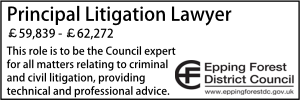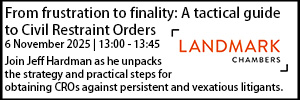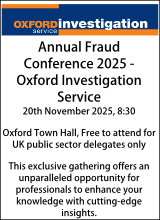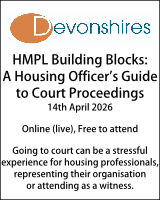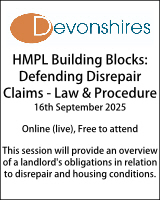Too little, too late? Applications to withdraw pre action admissions
- Details
What happens when a defendant seeks to withdraw a pre-action admission. Jeremy Warner explains.
Winding back the clock and withdrawing a pre-action admission is difficult. There is inevitably a tension between the finality of litigation and the interests of fairness. When a pre-action admission is made, the trajectory of a claim is set in motion. As the White Book commentary provides scant guidance on CPR 14.5, in this article I examine what happens when a defendant seeks to withdraw that admission, with particular focus on Somoye v North West Anglia NHS Foundation Trust [2023] EWHC 191 (KB) and the Court of Appeal’s guidance in Wood v Days Healthcare UK Limited [2017] EWCA Civ 2097.
Claimants and defendants alike must tread carefully. For claimants, the reversal of an admission could throw a case into disarray. Gestmin SGPS S.A. v Credit Suisse [2013] EWHC 3560 (Comm) principles come to the fore in that marshalling evidence long after memories have degraded over time is no easy feat. Mr Justice Leggatts aptly observed that “memories are fluid and malleable, being constantly re-written whenever they are retrieved.” [1] These comments reflect the evidential challenges a claimant may face when a case is re-opened or re-directed. For defendants, however, attempting to resile is equally fraught. It carries procedural and tactical strategies that require careful consideration.
Provisions
Pre-action admissions under CPR 14.5 can often be made early in the life of a dispute, sometimes with the intention of narrowing issues or signalling co operation. However, applications to withdraw such admissions are not granted lightly. The Court considers “all the circumstances of the case” but must also have regard to the list of factors set out in CPR 14.5(a)-(g). Said factors are not hierarchical. [2]
CPR 14.5:
In deciding whether to give permission for an admission to be withdrawn, the court shall consider all the circumstances of the case, including—
(a) the grounds for seeking to withdraw the admission;
(b) whether there is new evidence that was not available when the admission was made;
(c) the conduct of the parties
(d) any prejudice to any person if the admission is withdrawn or not permitted to be withdrawn;
(e) what stage the proceedings have reached; in particular, whether a date or period has been fixed for the trial;
(f) the prospects of success of the claim or of the part of it to which the admission relates; and
(g) the interests of the administration of justice.
CPR 14.5(a) – Grounds for Seeking to Withdraw the Admission AND CPR 14.5(b) – Whether there is new evidence that was not available when the admission was made
To understand these limbs, careful thought must be given to:
- The distinction between new evidence from material that could have been obtained earlier with due diligence; and
- Whether an increase in the value of a claim constitutes new evidence.
Somoye provides useful guidance on the former. In that case, the defendant made a pre-action admission by letter dated 24 March 2020 in respect of a clinical negligence claim, the day before the Inquest was listed. The deceased in Somoye attended hospital and underwent a laparotomy. She subsequently died of cardiac arrest. Before the Inquest, the Serious Incident Report identified numerous care and delivery issues relating to the deceased’s treatment. Prior to the Inquest, the coroner instructed Professor Winslet, Consultant Colorectal Surgeon. In his report, Professor Winslet stated that the deceased would not have suffered a cardiac arrest if she had received appropriate treatment (namely, nasogastric decompression). The Trust admitted liability in respect of the civil claim on 8 March 2019.
At the Inquest itself on 16 September 2021, Professor Winslet changed his view on causation, suggesting that different treatment would not have actually prevented the outcome. As a result, on 13 July 2022, the defendant applied to withdraw its pre-action admission on the basis that Professor Winslet “completely changed his mind whilst on the witness stand.”
However, the Court did not permit the defendant to withdraw its pre-action admission of liability. As set out by Master Sullivan in Somoye, parties are required to seek independent legal advice (and medical advice in the right circumstances) early on in the lifetime of a claim. Brandishing a new expert report, which is supportive of the defendant’s claim, may be “new” in the sense that it only recently came into existence. However, if it simply could have been sought before the pre-action admission was made, this is unlikely to suffice.
The same analysis applies to a witness amending their position. If a witness provides evidence to their legal team, but subsequently changes their mind on a particular factual issue later down the line, this is not “new” evidence. It is simply a change in stance.
This issue arose in a recent multi-track hearing of mine when the defendant sought to resile from a pre-action admission made in respect of breach of duty. The defendant suggested that one of their witnesses had provided new factual information relevant to liability, of which they were not previously aware. These arguments were dismissed by the Court on the basis that there is a distinction between genuinely new evidence, and a simple change in stance. “New” evidence may, for example, constitute new documentation, medical records or CCTV footage that was previously unavailable.
In other words, if there is simply a reassessment of the same material, this is not new evidence. Both claimants and defendants alike should therefore be careful to examine the chronology of the claim when examining this point.
Increase in value of claim
A dramatic increase in the value of a claim may constitute “new” evidence. For example, in Wood v Days Healthcare UK Limited [2017] EWCA Civ 2097, the defendant admitted liability in a personal injury claim after it was intimated to them by the claimant’s solicitors that the claim would be below £25,000 in value. Later, the claimant’s condition worsened and proceedings were commenced two years after the admission of liability. In the Particulars of Claim, damages in excess of £300,000 were sought.
At first instance, the defendant’s application to resile from their pre-action admission was refused. However, the Court of Appeal found this transformation in value was a significant factor. It drew a sharp distinction between the ordinary risk that personal injury claims may increase in value, and the exceptional change in value that occurred here. A large increase in value was not a minor escalation but rather changed the nature of the case and the risk calculus behind the admission. The Court of Appeal held that while the defendant had taken a commercial decision in making the admission, it was based on information available at the time. Denying withdrawal in the face of radically new facts would discourage early admissions, and would undermine the purpose of the pre-action protocol.
CPR 14.5(c) – Conduct of the Parties
A bad faith attempt to reverse an admission to gain a strategic advantage, particularly if the application is made late in the proceedings, will weigh heavily against the applicant. Examples of bad faith conduct may include:
- Making an admission to avoid expert or legal costs, only to later withdraw it once those costs are incurred by the claimant;
- Failure to engage meaningfully in the pre-action protocol, only to backtrack once formal litigation looms;
- Withholding relevant evidence or disclosure which could have clarified the position earlier, and
- Failing to take independent legal and/or medical advice at an early stage before making an admission.
CPR 14.5(d) – Any Prejudice to any person if the admission is withdrawn or not permitted to be withdrawn;
Defendants will always face prejudice if their application is refused, even if they are still open to challenge the extent of the losses if an admission of liability is made. The more pressing question is often whether allowing the withdrawal would unfairly prejudice the claimant.
As set out above, pre-action admissions shape the trajectory of a claim. If a pre action admission of liability is made, a claimant will not marshal evidence in respect of the admissions that are made; to do so would be disproportionate. As was the case in Somoye, claimants are unlikely to instruct Counsel for an inquest due to costs recovery. Withdrawing an admission later down the line changes the game. Key witnesses may have left employment, contemporaneous records may be lost, and memories fade. As observed by Mr Justice Leggatt, the passage of time degrades evidence.
In addition, claimants may spend unnecessary time and money investigating quantum, which would likely not have been incurred until the issue of liability was resolved. This point was noted in [45] in Somoye, although the emotional effects of withdrawing the pre-action admission on the family were not deemed to hold significant weight in that case.
CPR 14.5(e) – What stage the proceedings have reached; in particular, whether a date or period has been fixed for trial
The later the application is made, the greater the scrutiny. If trial is looming, the odds of a successful application dwindle. An early application, made transparently and with full disclosure, may stand a better chance.
It is also important to note that if defendants fail to deal with the admission in their Defence (and it is therefore taken to have been admitted in accordance with CPR 16.5) and then seek to resile from their pre-action admission, they are also required to file an amended Defence.
If a defendant does not do so, it is difficult for the claimant, as well as the Court, to fully understand the nature of their variation. A failure to do so can be indicative of a lack of preparedness or clarity as to how the case would proceed if the admission were withdrawn. Further, if a party has filed a Defence that does not expressly withdraw the pre-action admission, and has not denied the relevant allegations in the Particulars of Claim, the admission may well be treated as having been confirmed. Silence or ambiguity in the Defence can be fatal under CPR 16.5(5).
CPR 14.5(f) – The Prospects of Success of the Claim or the Part of it which the Admission Relates
Given there is no hierarchy of factors when considering CPR 14.5, both claimants and defendants should be alive to the fact that even if their case is ostensibly strong, this is not a knockout blow for the other side. Even in Somoye, Professor Winslet’s revised causation defence had “a real prospect of success in their case on causation” [3] but the application was still refused due to the other surrounding factors.
Both claimants and defendants should not descend into mini-trial territory, but should be prepared to articulate the strength of their position.
CPR 14.5(g) – the Interests of the Administration of Justice
This of course is a catch-all provision which allows the Court to look more widely at the factual matrix of the case. Readers will be well-versed with this concept. It permits the Court to consider not just the narrow facts of the case, but the broader impact on justice, including procedural regularity and the conduct of litigation more generally.
In Somoye, Master Sullivan addressed this carefully. It was accepted that liability admissions lead to a finding that the death was caused by negligence. However, it did not preclude the defendant from raising arguments about quantum or life expectancy. The administration of justice was not offended in this case, as the defendant was still open to argue that the deceased would have had a shortened life expectancy for unrelated reasons.
Conclusion
The hurdles are not insurmountable, but defendants must:
- Distinguish genuinely “new” evidence from material that could have been obtained earlier with reasonable diligence;
- Understand that the finality of litigation is a significant consideration;
- Reflect on whether the reason for revoking their admission is both sufficient and justifiable;
- Ensure that any amendment to a Defence (that might have repeated the pre action admission) is clear and properly pleaded;
- Accept that even if the underlying claim or defence has strong prospects of success, this is not in itself a knockout blow to the opposition under CPR 14.5;
- Acknowledge that early admissions shape the course of litigation, and withdrawing one alters that course substantially; and
- Understand that there is no hierarchy of factors in CPR 14.5.
Conversely, claimants should:
- Forensically scrutinise each factor under CPR 14.5 and reflect on the above factors;
- Challenge characterisations of “new” evidence. A reappraisal of witness evidence is unlikely to be sufficient, nor should expert evidence which could have been obtained earlier with due diligence;
- Highlight prejudice. Over time, evidence fades and memories degrade; and
- Emphasise delay. The longer the defendant has sat on the issue, the more weight finality of litigation will carry.
Ultimately, while the CPR allows for some flexibility, it is not a tool to escape consequences of poor strategic decisions. The concept of finality of litigation matters to all litigants who rely on admissions as a procedural anchor.
Jeremy Warner is a barrister at 3 Paper Buildings.
[1] [17]
[2] [29] Somoye
[3] [53]
Trust Solicitor (Employment & Contract Law)
Trust Solicitor (Public & Healthcare Law)
Locums
Poll
04-11-2025 9:00 am
06-11-2025
18-03-2026 1:00 pm














